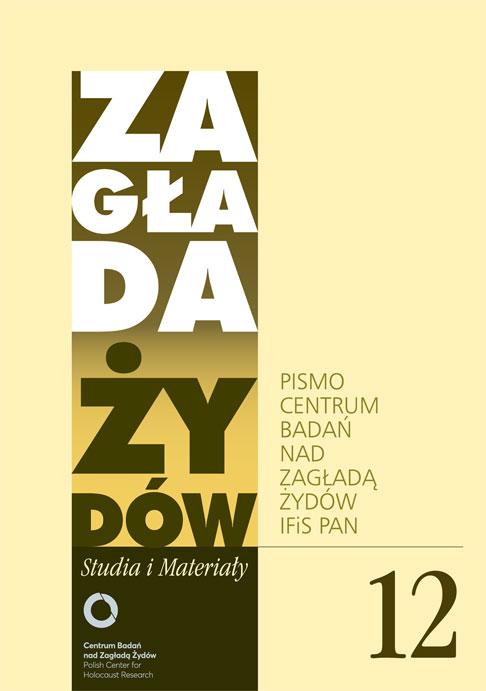Społeczeństwo holenderskie i los Żydów: skomplikowana historia
Zagłada Żydów. Studia i Materiały, Nr 12 (2016), Strony: 425-434
Data zgłoszenia: 2020-10-20Data publikacji: 2016-11-30
 https://doi.org/10.32927/ZZSiM.426
https://doi.org/10.32927/ZZSiM.426
Abstrakt
The percentage of victimization of Dutch Jewry during the Shoah is the highest of Western, Central and Southern Europe (except, perhaps of Greece), and close to the Polish one: 75%, more than 104.000 souls. The question of disproportion between the apparent favorable status of the Jews in society – they had acquired emancipation in 1796 - and the disastrous outcome of the Nazi occupation as compared to other countries in general and Western European in particular has haunted Dutch historiography of the Shoah. Who should be blamed for that outcome: the perpetrators, i.e. the Germans, the bystanders, i.e. the Dutch or the victims, i.e. the Dutch Jews? The article first surveys the answers given to this question since the beginnings of Dutch Holocaust historiography in the immediate post-war period until the debates of today and the factors that influenced the shaping of some basic perceptions on “Dutch society and the Jews”. It then proceeds to detailing several facts from the Holocaust period that are essential for an evaluation of gentile attitudes. The article concludes with the observation that – in spite of ongoing debates – the overall picture which has accumulated after decades of research will not essentially being altered. Although the Holocaust was initiated, planned and carried out from Berlin, and although a considerable number of Dutchmen helped and hid Jews and the majority definitely despised the Germans, considerable parts of Dutch society contributed to the disastrous outcome of the Jewish lot in the Netherlands – through a high amount of servility towards the German authorities, through indifference when Jewish fellow-citizens were persecuted, through economically benefiting from the persecution and from the disappearance of Jewish neighbors, and through actual collaboration (stemming from a variety of reasons). Consequently, the picture of the Holocaust in the Netherlands is multi-dimensional, but altogether puzzling and not favorable.
Słowa kluczowe
społeczeństwo holenderskie wobec Żydów , literatura o Zagładzie w Holandii
Licencja
Prawa autorskie (c) 2016 Autor&"Zagłada Żydów. Studia i Materiały"

Utwór dostępny jest na licencji Creative Commons Uznanie autorstwa 4.0 Międzynarodowe.
https://creativecommons.org/licenses/by/4.0
Czasopismo publikowane jest w standardzie Diamond Open Access na licencji CC-BY-4.0 Deed - Uznanie autorstwa 4.0 Międzynarodowa - Creative Commons
Inne teksty tego samego autora
- Avner Shalev, Dan Michman, David Silberklang, Ścisła pamięć o Zagładzie w Muzeum Historii Holokaustu w Yad Vashem. Odpowiedź na artykuł Amosa Goldberga , Zagłada Żydów. Studia i Materiały: Nr 7 (2011)
Podobne artykuły
- Ewa Koźmińska-Frejlak, A Testimony of Silence… Interview with Jerzy Lewiński, a former functionary of the Order Service in the Warsaw ghetto , Zagłada Żydów. Studia i Materiały: 2008: Holocaust Studies and Materials
- Grzegorz Motyka, Wołodymyr Wjatrowycz, Stawlennia OUN do jewrejiw. Formuwannia pozycji na tli katastrofy , Zagłada Żydów. Studia i Materiały: Nr 3 (2007)
- Michael Phayer, „Udzielanie pomocy Żydom nie jest rzeczą łatwą”. Polityka Watykanu wobec Zagłady – ciągłość czy zmiana? , Zagłada Żydów. Studia i Materiały: Nr 5 (2009)
- Iwona Kurz, “This picture is a little horrific”. The story of a film, or the Polish nation face-to-face with the Jew , Zagłada Żydów. Studia i Materiały: 2010: Holocaust Studies and Materials
- Miranda Brethour, Upamiętnianie Zagłady w kraju multikulturalizmu. Kanada wobec spuścizny Zagłady od lat siedemdziesiątych do chwili obecnej , Zagłada Żydów. Studia i Materiały: Nr 14 (2018)
- Daniel Logemann, Europejski wymiar Zagłady w książkach niemieckich historyków, czyli jak pisać o przemocy wobec Żydów wymierzonej nie przez Niemców , Zagłada Żydów. Studia i Materiały: Nr 14 (2018)
- Przemysław Nowicki, Zanim „przybył z zaświatów”, nazywał się Winer. Krąg rodzinny i konspiracyjny Szlamka, uciekiniera z ośrodka zagłady w Chełmnie nad Nerem , Zagłada Żydów. Studia i Materiały: Nr 5 (2009)
- Jacek Leociak, Stanisław Śreniowski, z księgi obłędu i ohydy , Zagłada Żydów. Studia i Materiały: Nr 1 (2005)
- Iwona Kurz, Ten obraz jest trochę straszliwy”. Historia pewnego filmu, czyli naród polski twarzą w twarz z Żydem , Zagłada Żydów. Studia i Materiały: Nr 4 (2008)
- Marta Janczewska, Wspomnienia, relacje, dzienniki – seria wydawnicza Żydowskiego Instytutu Historycznego INB , Zagłada Żydów. Studia i Materiały: Nr 3 (2007)
<< < 13 14 15 16 17 18 19 20 21 22 23 24 25 26 27 28 29 30 31 32 33 34 35 36 37 38 39 40 41 42 43 44 45 46 47 48 49 50 51 52 53 54 55 56 57 58 59 60 61 62 > >>
Możesz również Rozpocznij zaawansowane wyszukiwanie podobieństw dla tego artykułu.
 English
English
 Język Polski
Język Polski



 https://orcid.org/0000-0001-7496-496X
https://orcid.org/0000-0001-7496-496X

